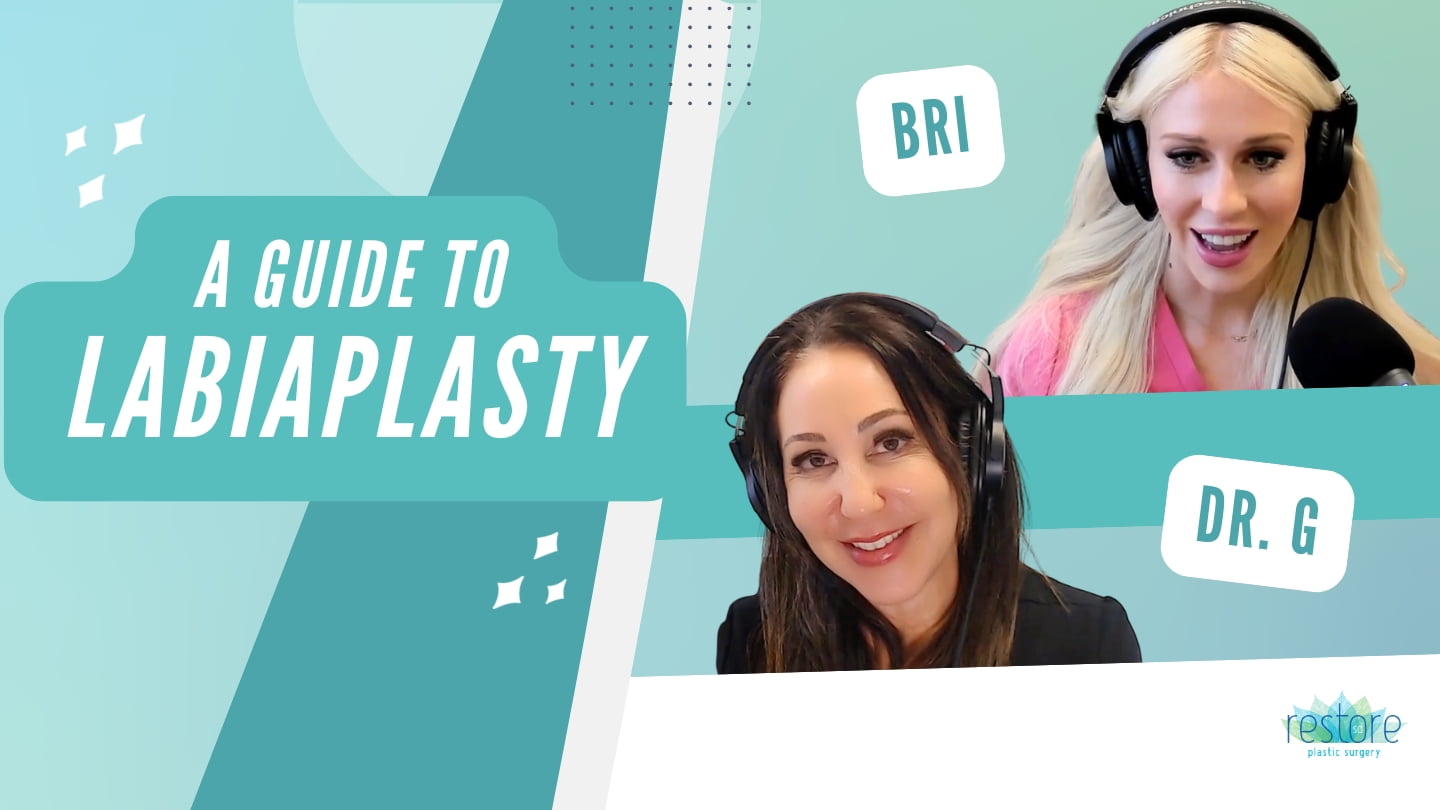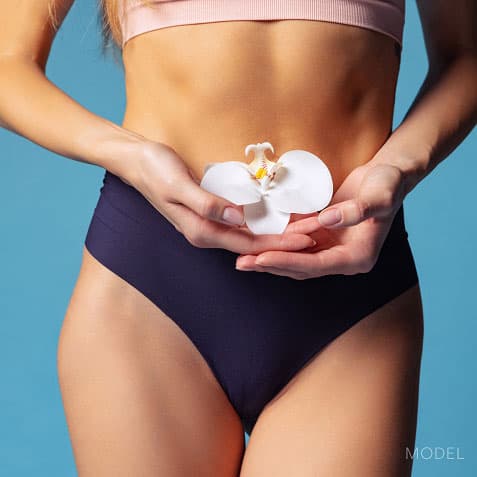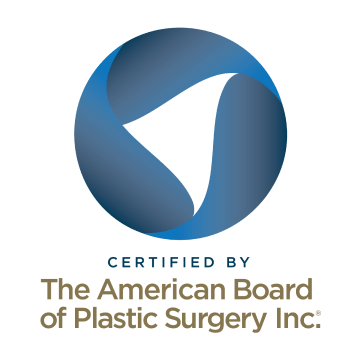Labiaplasty San Diego
Board-certified plastic surgeon Dr. Katerina Gallus has helped hundreds of labiaplasty patients at her San Diego practice, helping women feel more comfortable and confident. With advanced surgical techniques and a personalized approach, Dr. Gallus delivers safe, natural-looking results for patients seeking labiaplasty in La Jolla, CA and throughout the San Diego area.
It is common for women to have labia that sag or are irregularly shaped, since pregnancy, the natural aging process, weight fluctuations, and genetics all can affect the tissues of the vulva. Despite how normal this is, uneven or stretched labia can cause distress and discomfort—and labiaplasty can help you feel more at ease in your body.

“I highly recommend Dr. Gallus and her team. I was nervous about the whole process of a labiaplasty so I really appreciated how great her whole team was walking me through each step of the process and answering all my questions. Everyone was so professional, kind, patient and made the experience a very positive one. I felt listened to which is very important for me with such a personal surgery. Surgery day was a breeze and on post op day 1 I barely have any pain even without taking the pain medication.”
—Review from real labiaplasty patient of Dr. Gallus
View labiaplasty before & after photos »
With over 20 years of experience, Dr. Gallus is a board certified plastic surgeon and Castle Connolly Top Doctor. She will partner with you to develop a tailored surgical plan that prioritizes your safety and results.
What is labiaplasty surgery?
Labiaplasty is a surgical procedure performed to correct excess or uneven/asymmetric tissue in the vulva by reshaping and removing some tissues. During surgery, La Jolla plastic surgeon Dr. Katerina Gallus removes a wedge-shaped section of tissue or a longer, thin piece of tissue through excision. Most labiaplasties address enlarged inner labia, or labia minora, but labiaplasty can also address the labia majora (outer labia), the clitoral hood, or the area just over the pubic bone, the mons pubis.
As a result, this surgery can reduce physical discomfort connected with excess or sagging tissue in the labia, and can also help with any embarrassment or frustration with stretched labia.
Each individual’s anatomy and goals for their appearance are completely unique, so Dr. Gallus works with every labiaplasty patient to create a customized plan based on a frank, open conversation. There are multiple technique options: the wedge technique (also known as wedge resection) removes a wedge-shaped portion of the tissues and reshapes tissues to create the desired labia size and appearance. The trim technique uses an incision placed along the outer edges of the labia to remove a strip of excess tissues; the scar is hidden in the natural folds and contours of the labia.
During labiaplasty surgery, we first mark the area to be removed. Then, Dr. Gallus removes excess tissues and closes incisions with 3-4 absorbable sutures on either side. Assuming you carefully follow post-op instructions, patients are back to their regular routine after 3-5 days and back to exercise, sports, and other physical activities after about 4-6 weeks.
Video transcript
Labiaplasty is one of the more popular procedures that I perform in my office. What labiaplasty is is removal of excess tissue around the labia. It is a common procedure for women of all ages. You may be a good candidate for labiaplasty if you have excess tissue or asymmetry, and that excess tissue in the labia area is interfering with your ability to wear form-fitting clothing, swimsuits, participate in certain sporting activities, discomfort with intercourse, or just being self-conscious about that area. If you’re interested to know if labiaplasty is the right procedure for you, please go to our contact page and set up a consultation where we can go over your specifics in detail. We look forward to seeing you at RestoreSD plastic surgery.
Why do women choose labiaplasty?
Women undergo labiaplasty for reasons that are both cosmetic and functional. While your reasons are completely personal and there is no “wrong” reason to seek out labiaplasty, they may include:
- Friction or discomfort during physical activities
- Discomfort while wearing certain tight clothing, or during exercise or sexual intercourse
- Dissatisfaction with the genital appearance
- Desire for increased confidence
Labia come in many different sizes and shapes, and they can also change over time with the natural aging process, weight fluctuations, and childbirth. Some women are born with asymmetrical or enlarged labia. Some athletic women, including competitive dancers and swimmers, request an improved contour to minimize friction and simplify hygiene. Today’s trends toward hair removal and revealing intimate clothing also simply expose more anatomy, so patients may want labial reduction to refine their appearance in revealing or form-fitting clothes.

“Dr. Gallus and Bri are fantastic. I had a procedure I’ve wanted for an incredibly long time. There was no judgement. Scheduling and payment plans were a breeze. The staff is communicative, informative, and supportive of any decision you make. They will talk you through every step of your procedure so there is nothing unexpected. Every detail will be talked about in an informative way prior to making a commitment. Follow up is also a breeze. The staff is very available for serious or regular concerns.”
—Review from real labiaplasty patient
The Lady Bits: A Guide to Labiaplasty
Dr. Gallus and her scrub tech Bri chat all things labiaplasty in this episode of All the B’s, their fun and unfiltered plastic surgery podcast!
Am I a good candidate for this surgery?
To be a good candidate for labiaplasty, you should be in good health and not use any nicotine products—smoking, vaping, or otherwise. You may have discomfort due to your labial anatomy, some asymmetry, or a concern with excess skin in the labia. You will also need to be prepared to dedicate several days to rest as your body recovers from surgery, as well as avoid strenuous activity for 4-6 weeks.
Video transcript
People are often surprised at the wide range of ages of women that come seeking labiaplasty. I see young women who have issues before they even have children and then maybe having extra excess labia interferes with their ability to participate in sports. Older women who have had children, women who have had weight loss, and those who’ve had traumatic childbirth events in which case they have asymmetry or a tear in their labia. You may be a good candidate for labiaplasty if you are healthy, non-smoking, and have excess tissue that’s interfering with your ability to enjoy your day-to-day. If you’re interested to know if labiaplasty is the right procedure for you, please go to our contact desk page and set up a consultation where we can go over your specifics and detail. We look forward to seeing you at Restore SD Plastic Surgery.
Anesthesia for Labiaplasty
Labiaplasty can be performed under local anesthesia in our cosmetic surgery office or under general anesthesia in our on-site Quad A-accredited surgery center. Labiaplasty alone is usually performed with local numbing, but general anesthesia is more common if you are combining labiaplasty with other rejuvenation procedures.
Local Anesthesia
The labiaplasty procedure with local anesthesia takes one to two hours in our office, and you can go home immediately afterwards. You may request mild oral sedation in addition to the local numbing anesthetic, and if you do, we require that you have a designated driver to take you home after surgery.
To begin the procedure, we apply a topical numbing cream to the area, and mark the planned incisions on the area of concern (depending on your individual anatomy, Dr. Gallus may use a trim or wedge technique). Once the planned incisions are marked, Dr. Gallus injects a local anesthetic, as well. After anesthesia has taken effect, Dr. Gallus will then carefully remove the excess labia skin and surgically repair it in a way that minimizes visible scars or pigmentation changes. The repair is performed with dissolvable sutures, and ointment is applied.
General Anesthesia
If you are having surgery under general anesthesia, you will be administered anesthesia via an IV by our board-certified anesthesiologist. The surgery begins once you are completely asleep. Afterwards, you will need a trusted adult to drive you home and stay with you for at least 24 hours.
The Recovery Process
Most patients return to work and their regular, daily activities within a few days to 1 week after labial reduction surgery. During recovery, you will need to wear loose-fitting clothes and refrain from strenuous exercise. Dr. Gallus will clear you to return to sexual activity and exercise once you are ready, after about 6 weeks, when incisions are completely healed.
What type of results can I expect?
Your labiaplasty results will be completely customized based on the goals you share with your board-certified plastic surgeon in your personal consultation. For most patients, this looks like a reduction in size or a change in shape of the labia minora and/or labia majora.
Is labiaplasty permanent?
Yes, labiaplasty is considered to be long-lasting, although additional changes or stretching over time is possibly due to any future pregnancies, vaginal birth, weight changes, or menopause.
View labiaplasty before & after photos »
- Key Benefits of Labiaplasty
- Glossary
- Reduces discomfort, chafing and irritation
- Corrects asymmetry and reduces the size of the labia
- Makes personal hygiene practices easier by reducing the risk of infections
- Relieves pain experienced during intercourse, sports, or other activities due to elongated labia
- Provides permanent changes to the labial size and shape for long-term results
- Anesthesia: Medication administered to prevent pain during surgery. Labiaplasty can be performed under local anesthesia (numbing the area) with or without sedation, or under general anesthesia.
- Asymmetry: A common condition where the two labia minora or labia majora are not identical in size or shape. Labiaplasty can correct asymmetry for a more balanced appearance.
- Dyspareunia: Painful intercourse, which can sometimes be alleviated with labiaplasty if the discomfort is caused by enlarged or elongated labia.
- General Anesthesia: A type of anesthesia that causes a temporary loss of consciousness to prevent pain and discomfort during surgery.
- Hymen: A thin membrane partially covering the entrance to the vagina. Labiaplasty does not involve the hymen but focuses on the labia minora and/or labia majora.
- Labia Majora: The outer, larger labial folds that enclose and protect the rest of the external genitalia. Labiaplasty can be performed on the labia majora to reduce size or improve contour.
- Labia Minora: The inner, smaller labial folds located inside the labia majora, directly surrounding the clitoral hood, vaginal opening, and urethral opening. Labiaplasty often involves reducing the size of the labia minora.
- Labiaplasty: A surgical procedure aimed at reducing the size or reshaping the labia minora and/or labia majora to alleviate discomfort or achieve a desired aesthetic appearance.
- Local Anesthesia: Anesthesia applied to a specific area to numb it, used in labiaplasty to prevent pain while the patient remains awake.
- Postoperative Care: Instructions and care practices to follow after surgery, such as labiaplasty, to ensure a smooth and safe recovery.
- Recovery Time: The period needed to heal after labiaplasty, typically ranging from a few days to a week for initial recovery and longer for complete healing.
- Reduction Labiaplasty: A specific type of labiaplasty focused on reducing the size of the labia minora or labia majora to relieve symptoms or achieve a preferred aesthetic outcome.
- Revision Labiaplasty: A subsequent procedure performed to correct or improve the results of an initial labiaplasty.
- Sedation: The use of medication to help patients relax during a procedure. For labiaplasty, sedation may be used in conjunction with local anesthesia.
Non-surgical Feminine Rejuvenation vs. Surgery
Advances in laser treatment allow you to have a non-surgical, simple in-office treatment that can improve vaginal tone, lubrication, dryness, discomfort during intercourse, and even mild urinary incontinence—no surgery required. Vaginal rejuvenation with laser treatment accomplishes these results by increasing collagen production to improve the tissues’ health in the vagina. On the other hand, labiaplasty is a surgical procedure that exclusively focuses on removing and/or reshaping the tissues of the vulva, or external genitalia. We offer both options at our practice.
Frequently Asked Questions About Labiaplasty

“I recently had a procedure done to reduce the discomfort I have with my body & Dr. Gallus & Bri are amazing! I was very much anxious about this procedure since I’ve never done anything else but they were both super helpful answering all my questions & easing my anxiety. I’m now post 3-ish months & my life has definitely improved much more than it was prior to the procedure.”
—Review from real labiaplasty patient of Dr. Gallus
Labiaplasty Videos
A Guide to Labiaplasty
Labiaplasty Recovery: What to Expect
How Labiaplasty Works
Labiaplasty Techniques: Which One is Right for You?
Why Women Don’t Talk About Labiaplasty
Anesthesia for Labiaplasty
Is labiaplasty recovery painful?
The truth about labiaplasty stitches (and when they disappear)
What if I have my period on the same day my labiaplasty surgery is scheduled?
Labiaplasty recovery for out of town patients
Biggest Fears About Anesthesia
What are the risks of labiaplasty?
Labiaplasty recovery for out of town patients
Come for the labiaplasty, stay for the gossip
How does labiaplasty work?
Labiaplasty: What To Expect
Why do women get labiaplasty?
How long does labiaplasty take?
In this video, female board-certified plastic surgeon Dr. Katerina Gallus demonstrates how labiaplasty is performed using the trim technique, and discusses what you can expect at the consultation, why women choose labiaplasty, and how surgery works. Dr. Gallus has helped numerous San Diego & La Jolla women feel more confident and comfortable with labial reshaping or reduction.
Video transcript
Hi, I’m Dr. Katerina Gallus and we’re gonna do a little demonstration of labiaplasty. The flower and the blue towels are representing the labia majora and labia minora. And this would be the clitoral hood right here. And so for a lot of reasons women choose to have the excess labia minora trimmed. And there’s a several ways you can do this operation but my preferred way because it leaves a lovely scar that’s hidden, is to do a trim. And so in the office at your consultation, I will mark this area for you so that you can see what is going to be removed and we can agree on a plan before any surgery happens. So this would be marking for excision of excess labia. Women have this done for very many reasons to include just getting in the way of clothing, chaffing with athletic activity, problems with different sports. And so then once the area is marked and everything is appropriately numbed then the excess tissue is trimmed. And then I’m gonna trim off the excess. Like that. So again it’s very important to mark prior to doing the surgery because we are infiltrating local anesthesia. And so we have to rely on our markings once that’s done. So this would be an example of excess labia removed. And then it’s very simple to just suture up this area with – this is not an absorbable suture – but normally I would use an absorbable suture -it’s just this blue color. And then you just suture it like so. And then these sutures are absorbable and fall out on their own. And we would place two or three more sutures along each edge depending on the length of the labia. And then with appropriate post-op activities you can be back to your work in three to five days and back to physical exercise and activity in four to six weeks.
Schedule your consultation with Dr. Gallus
Ready to learn about your options? We’re here to help! We invite you to schedule your consultation with Dr. Gallus today by calling 858-224-2281 or filling out our online contact form.
Call to schedule your consult today »
Medically reviewed by Dr. Katerina Gallus — Updated on Sep 12, 2025
References
Gallus, Katerina. Labiaplasty: A Comprehensive Review of Indications, Techniques, and Outcomes, Advances in Cosmetic Surgery, 2025, https://doi.org/10.1016/j.yacs.2025.01.003.
Özer M, Mortimore I, Jansma EP, Mullender MG. Labiaplasty: motivation, techniques, and ethics. Nat Rev Urol. 2018 Mar;15(3):175-189. doi: 10.1038/nrurol.2018.1. Epub 2018 Feb 6. PMID: 29405204.
Sasson DC, Hamori CA, Placik OJ. Labiaplasty: The Stigma Persists. Aesthetic Surgery Journal. 2022 May 18;42(6):638-643. doi: 10.1093/asj/sjab335.
Willis RN, Wong CS, Pai A, Patel BC. Labiaplasty Minora Reduction. 2023 Apr 3. In: StatPearls [Internet]. Treasure Island (FL): StatPearls Publishing; 2023 Jan–.
Oranges CM, Sisti A, Sisti G. Labia minora reduction techniques: a comprehensive literature review. Aesthet Surg J. 2015 May;35(4):419-31. doi: 10.1093/asj/sjv023. PMID: 25908699.
Furnas HJ. Trim Labiaplasty. Plastic and Reconstructive Surgery Global Open. 2017 May 23;5(5):e1349. doi: 10.1097/GOX.0000000000001349.
Rowley M, Thawanyarat K, Shah J, Nazerali R. Labiaplasty and Insurance: To Cover or Not to Cover? Archives of Plastic Surgery. 2022 Apr 6;49(2):285-286. doi: 10.1055/s-0042-1744428.
Your Safety = Beautiful Labiaplasty Results
Labiaplasty at Restore SD
At Restore SD Plastic Surgery, patient safety comes first. Board-certified plastic surgeon and former Navy plastic surgeon Dr. Katerina Gallus operates in a private, on-site Quad A-accredited surgery center, with state-of-the-art equipment and LED surgical lighting. She proudly works with a board-certified anesthesiologist and holds privileges at Scripps Memorial Hospital La Jolla.
Labiaplasty blog posts from Dr. Gallus
 Labiaplasty: When Is It Covered By Insurance?
Labiaplasty: When Is It Covered By Insurance? Is Labiaplasty Right for Me?
Is Labiaplasty Right for Me? Podcast: The Lady Bits, A Guide to Labiaplasty by San Diego Female Plastic Surgeon
Podcast: The Lady Bits, A Guide to Labiaplasty by San Diego Female Plastic Surgeon













